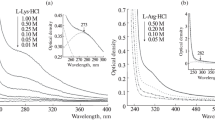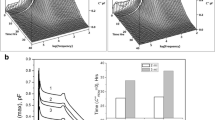Abstract
The influence of l-arginine on the temperature-induced aggregation of porcine and mink growth hormones was studied by fluorescence spectroscopy. It was found that l-arginine suppresses the heat-induced aggregation. Moreover, the analysis of l-arginine interaction with the native proteins by fluorescence spectroscopy and circular dichroism spectroscopy revealed no significant changes in their native structure. On the basis of the results, l-arginine could be considered as a potential additive for the prevention of storage and temperature-related denaturation and aggregation of veterinary growth hormones.












Similar content being viewed by others
References
Manning, M. C., Chou, D. K., Murphy, B. M., Payne, R. W., & Katayma, D. S. (2010). Stability of protein pharmaceuticals: an update. Pharmaceutical Research, 27, 544–575.
Mahler, H. Ch., Friess, W., Grauschopf, U., & Kiese, S. (2009). Protein aggregation: Pathways, induction factors and analysis. Journal of Pharmaceutical Sciences, 98, 2909–2934.
Wang, W. (2005). Protein aggregation, its inhibition in biopharmaceutics. International Journal of Pharmaceutics, 289, 1–30.
Arakawa, T., Tsumoto, K., Kita, Y., Chang, B., & Ejima, D. (2007). Biotechnology applications of amino acids in protein purification and formulations. Amino Acids, 33, 587–605.
Lange, C., & Rudolph, R. (2009). Suppression of protein aggregation by l-arginine. Current Pharmaceutical Biotechnology, 10, 408–414.
Arakawa, T., & Tsumoto, K. (2003). The effects of arginine on refolding of aggregated proteins: Not facilitate refolding, but suppress aggregation. Biochemical Biophysical Research Communications, 304, 148–152.
Maity, H., Karkaria, C., & Davagnino, J. (2009). Effects of pH and arginine on the solubility and stability of a therapeutic protein (Fibroblast Growth Factor 20): Relationship between solubility and stability. Current Pharmaceutical Biotechnology, 10, 609–625.
Maity, H., O’Dell, C., Srivastava, A., & Goldstein, J. (2009). Effects of arginine on photostability and thermal stability of IgG1 monoclonal antibodies. Current Pharmaceutical Biotechnology, 10, 761–766.
Kim, H. J., Shin, Ch., Ch, W., & Kim, H. (2009). Stabilization of glycoprotein liquid formulation using arginine: A study with lactoferrin as a model protein. Bioscience, Biotechnology and Biochemistry, 73, 61–66.
Parkinson, E. J., Morris, M. B., & Bastiras, S. (2000). Acid denaturation of recombinant porcine growth hormone: Formation and self-association of folding intermediates. Biochemistry, 39, 12345–12354.
Sillence, M. N. (2004). Technologies for the control of fat and lean deposition in livestock. The Veterinary Journal, 167, 242–257.
Klindt, J., Buonomo, F. C., & Yen, J. T. (1992). Administration of porcine somatotropin by sustained-release implant: Growth and endocrine responses in genetically lean and obese barrows and gilts. Journal of Animal Science, 70, 3721–3733.
Klindt, J., Buonomo, F. C., & Yen, J. T. (1995). Administration of porcine somatotropin by sustained-release implant: Growth, carcass and sensory responses in crossbred and genetically lean and obese boars and gilts. Journal of Animal Science, 73, 1327–1339.
Sereikaite, J., Statkute, A., Morkunas, M., Radzevicius, K., Borromeo, V., Secchi, C., et al. (2007). Production of recombinant mink growth hormone in E. coli. Applied Microbiology and Biotechnology, 74, 316–323.
Borromeo, V., Sereikaite, J., Bumelis, V. A., Secchi, C., Scire, A., D’Auria, S., et al. (2008). Mink growth hormone structural-functional relationships: Effects of renaturing and storage conditions. The Protein Journal, 27, 170–180.
Baranauskaite, L., Sereikaite, J., Gedminiene, G., Bumeliene, Z., & Bumelis, V. A. (2005). Refolding of porcine growth hormone from inclusion bodies of Escherichia coli. Biocatalysis and Biotransformation, 23, 185–189.
Bajorunaite, E., Sereikaite, J., & Bumelis, V. A. (2007). l-Arginine suppresses aggregation of recombinant growth hormones in refolding process from E. coli inclusion bodies. The Protein Journal, 26, 547–555.
Duy, C., & Fitter, J. (2006). How aggregation and conformational scrambling of unfolded states govern fluorescence emission spectra. Biophysical Journal, 90, 3704–3711.
Szabo, A. G. (2000). Fluorescence principles and measurement. In M. G. Gore (Ed.), Spectrophotometry and spectrofluorimetry: A practical approach (pp. 33–67). London: Oxford University Press.
Rondeau, P., Navarra, G., Cacciabaudo, F., Leone, M., Bourdon, E., & Militello, V. (2010). Thermal aggregation of glycated bovine serum albumin. Biochimica Biophysica Acta, 1804, 789–798.
Reddy, K. R. C., Lilie, H., Rudolph, R., & Lange, C. (2005). l-arginine increases the solubility of unfolded species of hen egg white lysozyme. Protein Science, 14, 929–935.
Hamada, H., Arakawa, T., & Shiraki, K. (2009). Effect of additives on protein aggregation. Current Pharmaceutical Biotechnology, 10, 400–407.
Shiraki, K., Kudou, M., Fujiwara, S., Imanaka, T., & Takagi, M. (2002). Biophysical effect of amino acids on the prevention of protein aggregation. Journal of Biochemistry, 132, 591–595.
Ishibashi, M., Tsumoto, K., Tokunaga, M., Ejima, D., Kita, Y., & Arakawa, T. (2005). Is arginine a protein-denaturant. Protein Expression and Purification, 42, 1–6.
Bloemendal, M., & Johnson, W. C., Jr. (1995). Structural information on proteins from circular dichroism spectroscopy. In J. N. Herron, W. Jiskoot, & D. J. A. Crommelin (Eds.), Physical methods to characterize pharmaceutical proteins (pp. 65–100). New York: Plenum Press.
Ghosh, R., Sharma, S., & Chattopadhyay, K. (2009). Effect of arginine on protein aggregation studied by fluorescence correlation spectroscopy and other biophysical methods. Biochemistry, 48, 1135–1143.
Tousoulis, D., Boger, R. H., Antoniades, C., Siasos, G., Stefandi, E., & Stefandis, C. (2007). Mechanisms of disease: l-Arginine in coronary atherosclerosis—a clinical perspective. Nature Clinical Practice Cardiovascular Medicine, 4, 274–283.
Tripathi, P., Chandra, M., & Misra, M. K. (2009). Oral administration of l-arginine in patiens with angina or following myocardial infarction may be protective by increasing plasma superoxide dismutase and total thiols with reduction in serum cholesterol and xanthine oxidase. Oxidative Medicine and Cellular Longevity, 2, 231–237.
Tripathi, P., & Misra, M. K. (2009). Therapeutic role of l-arginine on free radical scavenging system in ischemic heart diseases. Indian Journal of Biochemistry and Biophysics, 46(6), 498–502.
Kawano, H., Motoyama, T., Hirai, N., Kugiyama, K., Yasue, H., & Ogawa, H. (2002). Endothelial dysfunction in hypercholesterolemia is improved by l-arginine administration: possible role of oxidative stress. Atherosclerosis, 161, 375–380.
Author information
Authors and Affiliations
Corresponding author
Rights and permissions
About this article
Cite this article
Cirkovas, A., Sereikaite, J. Probing of l-Arginine as an Additive for the Temperature-Induced Aggregation of Veterinary Growth Hormones: Fluorescence Study. Mol Biotechnol 49, 11–18 (2011). https://doi.org/10.1007/s12033-010-9370-6
Published:
Issue Date:
DOI: https://doi.org/10.1007/s12033-010-9370-6




